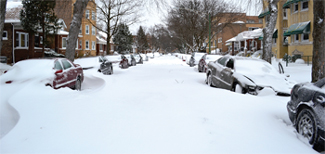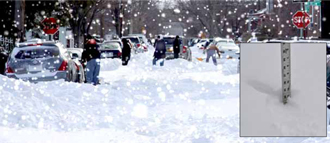
CHICAGO (FinalCall.com) – Severe weather across parts of the United States in 2010 resulted in 81 disaster declarations by the Federal Emergency Management Agency (FEMA).
That total was the most of any year on record and nearly three times the annual average of 33.
Already this year, FEMA has declared major disasters or emergencies in New Jersey, Missouri and Oklahoma, due to winter snowstorms, Maine due to severe storms and flooding, and California, due to flooding, debris and mudflows. With parts of the country receiving wave after wave of winter punishment, that previous 2010 total could be eclipsed.
What has gone underreported is that the brutal snowstorms pummeling many cities are weakening the already tenuous financial situations of those cities. Above normal and record snowfalls in many cases have depleted existing budgetary allocations for snow removal.
In Chapter 36 of his book The Fall of America, published in 1973, the Honorable Elijah Muhammad writes:
“Snow is of the most dreaded plague when it comes in great drifts from five to thirty-five feet. It buries your property and lives. It destroys your highways, your cities, and your concrete and gravel in towns and cities. It puts a great burden of expense upon the cities. It puts a great burden of expense upon the city to repair it. The cave-in of roofs of homes, the cutting off of homes, the cutting off of transportation, isolating areas, brings about starvation. And communication is destroyed with the icing of communication wires.”
In numerous cities across the United States of America, these prophetic words are being fulfilled.
In Chicago, a city, which prides itself on maintaining a “business as usual” atmosphere while successfully navigating heavy snowfall with minimal disruption, hundreds of cars were stranded on a major thoroughfare, Lake Shore Drive, which connects the north and south sides of the city Feb. 1. Traffic became snarled when whipping winds created swirling blankets of snow reducing visibility to almost zero. Ice blocks and slippery conditions developed along Chicago’s lakefront as Lake Michigan’s waves were tossed about by wind gusts topping 70 miles per hour. The treacherous driving conditions rendered travel completely impossible. Dozens were trapped in their cars for between 10 and 12 hours before being rescued by members of Chicago’s Emergency Management team.
Chicago’s bustling downtown area resembled a ghost town for nearly two days, with those choosing to brave the hostile conditions forced to walk down the middle of usually busy traffic clogged streets because the sidewalks were blocked by high snow banks.
A recent analysis and report from the retail consulting firm Melaniphy & Associates Inc., reported Chicago-area businesses lost revenue in the area of $600 million due to business closings and reduced customer traffic on Feb. 1 and 2.
Chicago’s Public Schools were completely closed for two days and with some schools remaining closed for a third due to mountains of snow several feet high still blocking side streets. Tens of thousands lost power, with many repairs delayed because the snow blocked access to power lines. The storm, which turned Chicago into what many in the blogosphere are calling “Chiberia,” resulted in the third highest snowfall ever recorded, 20.2 inches.
While still digging out from the historic blizzard just days earlier, Chicagoans were hit with a blast of arctic temperatures including below zero wind chills as another two to four inches of snow fell in some areas Feb. 6. The forecast for the next few days expected to see high temperatures only in the low teens, with lows possibly hovering near 10 degrees below zero.
Since the middle of December 2010, there has been one harsh snowstorm after the other.
There have been record snowstorms in many cities: Tulsa, Oklahoma experienced 14 inches of snow, Moline, Illinois received 18.4 inches. According to meteorologists at The Weather Channel, the recent storm system–which stretched, more than 2,000 miles–held the potential to impact nearly100 million people.
Snow and ice hampered travel and commerce leading up to the NFL’s Feb. 6 Super Bowl XLV hosted at Cowboys Stadium in the Dallas-Ft.Worth area. In fact, ice fell from the roof of the stadium Feb. 4 injuring at least six people. Typically, the week prior to the Super Bowl is filled with parties and promotional events that generate capital for the host city and many businesses. Many events were canceled, those still held experienced lower attendance because of inclement weather and altered travel schedules due to canceled and delayed flights.
The heavy demand on energy brought about by the unusually cold weather caused rolling blackouts in other parts of Texas, while natural gas shortages are being experienced in New Mexico.
In Muskogee, Oklahoma, several vehicles where damaged when a convenience store’s aluminum canopy collapsed due to heavy snow accumulation. Roof collapses were reported in such diverse areas as New England and Missouri due to the heavy snow. Coats of ice two to four inches thick have been reported from areas of the Midwest to the East Coast.
Food price increase?
The most recent storm could also affect food prices.

According to the Associated Press wheat prices rose Feb. 3 on speculation that the storm which roared across the U.S. might have damaged crops in the Great Plains region with its subzero temperatures.
The Northeast is suffering through one of its most brutal winters in years, with cities all along the seaboard reporting snow piling up at a record-setting pace. Connecticut has been especially hard-hit, with Hartford reporting 81 inches since Dec. 1, compared with an average of 46 inches, according to the National Weather Service. Though used to dealing with cold weather, the region is having a different experience with the frequency and mixture of this season’s severe weather.
Snow and ice has caused collapses requiring costly repairs, killing animals and destroying tools and supplies. Reportedly, Connecticut farmers have lost at least 136 barns, greenhouses, sheds and other structures as snow accumulated while January passed without a thaw. Recently 85,000 chickens and 14 dairy cows were killed when a coop collapsed. Losses are still being totaled by the state Agriculture Department and Commissioner Steven Reviczky says no one can remember a more destructive winter.
It may seem contradictory or unusual, however even after experiencing record snowfall in many regions, some areas of the U.S. are still experiencing severe drought conditions. According to hydrologists from the National Weather Service, two feet of snow translates to only about an inch of precipitation, the significant snow will help, but won’t have as much impact as many would think.
The National Drought Mitigation Center based in the School of Natural Resources at the University of Nebraska—Lincoln maintains the Drought Impact Reporter, which is based on news reports complied from more than 5,000 online media sources and reports from private citizens and governmental officials.
According to the broad-scale conditions researched and reported by the U.S. Department of Agriculture, NDMC, the U.S. Dept. of Agriculture and The National Oceanic and Atmospheric Administration the National Association, as of Feb. 1 the climate condition in a majority of the states in the South, Southwest and Southeast have areas described as experiencing “extreme or exceptional drought.”
Earthquakes
Many recall the 7.0 magnitude earthquake that decimated Haiti Jan. 12, 2010 killing an estimated 223,000 people, injuring 300,000 and displacing even more, however, there were several earthquakes recorded in 2010 equal to or greater than that one, terms of magnitude which occurred following a dire warning delivered by the Honorable Minister Louis Farrakhan during his Feb. 28, 2010 Saviours’ Day keynote address at the United Center in Chicago, Ill.
Referencing the Haiti earthquake and the earthquake registered in Chile just hours earlier The Minister said there would be more earthquakes like those, and they will also hit America.
“I am telling you: When I finish this lecture–today!–God is going to answer what I said!” thundered Minister Farrakhan. “You’ll see The Wheels over the major cities and the chastisement is going to increase and there will be earthquakes in America like you saw in Haiti! Like you saw in Chile!”
Last year, a June 16 7.0 magnitude earthquake near the North Coast of Papua Indonesia killed 17, a quake registering 7.2 hit Baja California, Mexico on Apr. 4, a 7.8 magnitude quake hit the Kepulauan Mentawai region in Indonesia on Oct. 25 and the largest earthquake–registering 8.8 in magnitude–was the one that hit offshore Bio-Bio, Chile on Feb. 27, 2010 killing 577, injuring 12,000 and displacing over 800,000.
According to the United States Geological Survey, a Federal agency responsible for recording and reporting earthquake activity, an estimated 75-million Americans in 39 states are at risk. The USGS estimates that several million earthquakes occur in the world each year, however many go undetected because they occur in remote areas or have very small magnitudes.
Hurricanes
According to NOAA the 2010 Atlantic hurricane season, was one of the busiest ever recorded. There were a total of 19 named storms which tied 1887 and 1995 for third highest on record. Of those, 12 became hurricanes–tied with 1969 for the second highest on record. Five of those reached major hurricane status of Category 3 or higher. Hurricane season in the Atlantic begins June 1st and ends November 30th.
Floods
America has also seen its share of flooding over the past year and unfortunately for many, it appears as if there is more flooding to come. Hydrologists for the National Weather Service ominously warned Feb. 3 that towns along the upper part of the Mississippi River could be in for “significant” flooding this spring.
The NWS office in St. Louis released its “Spring Flood Outlook” reporting that tributaries are already running high, soil in northern states is saturated, and cold weather has kept snow from melting. Meanwhile, precipitation is expected to be above normal for February.
The NWS said the probability of major flooding is as high as 80 percent at a few spots in Minnesota, Wisconsin, Iowa and Illinois, and nearly as high in parts of northeast Missouri.
The Hon. Elijah Muhammad in Chapter 35 of The Fall of America writes, “The four great judgments that Almighty Allah (God) is bringing upon America are rain, hail, snow and earthquakes. We see them now covering all sides of America, as the Holy Qur’an prophesies curtailing on all her sides,” he continues, “Job, in the Bible, prophesied that Allah (God) has the snow and ice to use as His weapon in the day of war and battle against the wicked. We hear and read in the newspapers today of how great, hill-like, little mountains of snow are pushing down from the north not only in the northern states of Minnesota, North and South Dakotas and Montana; but now the snow is in the New England States and they are declared to be disaster areas. The announcer of the disaster of snow in the New England States said that there have never been such great quantities of snow. All up and down the coast to the Carolinas, the rain takes up where the snow leaves off,” he continues. “The forces of nature are great weapons as we see them in play upon America. Storms after storms of snow and ice are rolling in from the North and are pushing great drifts that are just covering up everything. What can you do with a God like that?”
(The Associated Press contributed to this report.)












